英汉互译中颜色词的非对应翻译策略研究论文
英文本科毕业论文《从颜色词看中英文化差异》.doc

从颜色词看中英文化差异摘要我们生活在五彩缤纷、五颜六色的世界中,颜色的多样性造成了与之相对应的颜色词的丰富多彩。
颜色词除了可以表示最基本的大自然绚丽色彩的意义以外,在某种程度上也体现了人类的一些价值观和审美观。
在这种情况下,颜色词已不单纯是表示客观颜色的指称意义了,而是被赋予了不同的象征意义,而不同文化背景的人们对颜色的感知和审美体验是同中有异,异中有同。
本文将选取几个典型的颜色词来分析颜色词在中英文化中所存在的共性和差异性,探讨形成这种差异性的各种原因,并浅略讲述其对跨文化沟通、交流的影响及解决办法。
关键词:颜色词联想意义文化差异跨文化交际Chinese and English Cultural Differences Reflected in the ColorTermsAbstractAs we live in a colorful world, the diversity of colors results in the diversity of the equivalent color terms. Apart from expressing the most basic colors in the nature, colors, to some extent, represent some values and aesthetics of the mankind. In this case, color terms no longer merely express the designative meaning of the objective colors. They are given different symbolic meanings. People with different cultural background have different perceptions and aesthetic experience about colors, in which similarities can be found.This paper will select a few typical color terms to analyze the similarities and differences of color terms in Chinese and English cultures, discuss various reasons for these similarities, and touches upon their influence on the cross-cultural communication and exchanges and the solutions.Key words:color terms, associative meaning, cultural differences, cross-cultural communication目录引言 (1)1、中英两种文化中的颜色词及在跨文化交际中的翻译误区 (1)1.1、中英两种文化中的颜色词 (1)1.2、跨文化交际中颜色词的翻译误区 (1)2、颜色词在中英文化中的不同内涵,其共性与差异性 (1)2.1、白色(white) (2)2.2、红色(red) (2)2.3、黄色(yellow) (3)3、颜色词在中英文化中形成差异性的原因 (3)3.1、文化差异的原因 (4)3.2、价值取向的原因 (4)3.3、思维方式的原因 (5)3.4、宗教方面的原因 (5)3.5、其它原因 (5)4、颜色词的差异性对跨文化交流的影响 (6)5、在跨文化交流中应如何正确理解和翻译颜色词 (6)5.1、直译法 (6)5.2、意译法 (6)5.3、更换颜色词的翻译法 (7)5.4、增加颜色词的翻译法 (7)6、结语 (7)7、参考文献 (8)从颜色词看中英文化差异引言色彩与人类的生活息息相关,是人类认识世界的一个重要领域。
中英颜色词文化内涵差异研究英语专业毕业论文
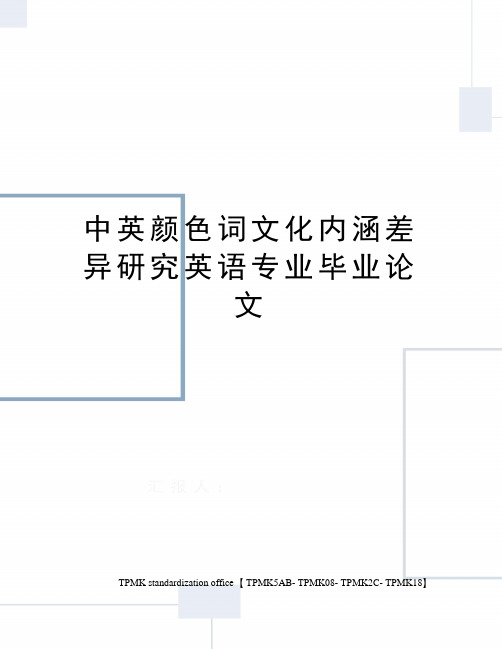
中英颜色词文化内涵差异研究英语专业毕业论文TPMK standardization office【 TPMK5AB- TPMK08- TPMK2C- TPMK18】论文题目中英颜色词文化内涵差异研究系别英语系专业英语外贸年级 2011级学号学生姓名邓显雯指导教师李彤完成时间 2015 年 4 月肇庆学院教务处制An Exploration into Connotative Difference between Chinese and English Color WordsA ThesisSubmitted to the School of Foreign Languages ofZhaoqing Universityin Partial Fulfillment of the Requirementsfor the Degree of Bachelor of EnglishBy:Deng XianwenSupervisor:Li TongApril 2015学术诚信声明本人所呈交的毕业论文,是在指导教师的指导下独立完成。
研究工作所取得的成果、数据、图片资料均真实可靠。
除文中已注明引用的内容外,不包含任何其他人或集体已经发表或撰写过的作品或成果。
对本论文的研究做出重要贡献的个人和集体,均已在文中以明确的方式标明。
本毕业论文的知识产权归属于培养单位。
本人完全意识到本声明的法律结果由本人承担。
本人签名:日期:AbstractLanguage is the essential component and representation of national culture, which was created and developed via hosting its own culture features in the process of historical development. Color words are the indispensable part of national culture as well. Territory, custom, politics, religion and value difference results in connotative meanings of color words difference between Chinese and English culture.The paper is focus on analyzing the explanation and cultural connotation of color words “Red”, “Green” and “Blue” as follow. Firstly, it introduces the Sapir Wolfe hypothesis as well as the Berlin and Kay basic color theory. Then the similarities and difference description and cultural connotation of Chinese and English basic color words “Red”, “Green” and “Blue” are presented. The third is the causes of cultural similarities and difference of the three color words. Including the difference between natural environment, tradition and customs, philosophic and religious views. Last but not least, the enlightenment from the contrast that the interaction of color words connotation and cultural influence is what causes the similarities and difference among them.Key words: basic color words “Red”, “Green” and “Blue”; cultural connotation similarities and difference; causes; interaction内容摘要各民族在其历史发展过程中创造和发展起来的具有本民族的特点文化,称为民族文化,而语言既是民族文化的重要组成部分,也是民族文化的表现形式。
浅论汉译英时颜色词的不对应性

浅论汉译英时颜色词的不对应性[摘要]颜色词不仅反映着色彩的物理属性,还具有多种多样的象征意义和引申意义,由于使用不同语言的民族具有各自不同的文化特征,同样的颜色词在汉语和英语中可能对应着不同的意义,因而在汉译英时往往不能对等翻译。
本文对红、青、白、黑四种基本颜色在汉译英时的不对应性进行了探讨。
[关键词]汉译英颜色词不对应性从反映的色彩的物理属性来看,汉英颜色词的基本意义是一致的,但是由于各民族在长期的历史发展过程中积淀了不同的生理、心理和文化的特征,因而同样的颜色词在不同民族中所代表的意义也有所差异,这种差异是引起文化含义误解和语用意义混淆的重要原因。
以下仅从红、青、白、黑四种基本颜色在汉语和英语中的不对应性来作一探讨。
(一)红色从表现的物理属性来看,英语和汉语中的“红色”是基本对应的,如“红星”(red star),“红叶”(red autumnal leave),“红豆”(red bean)等。
但是中国哲学讲求“虚”,注重“神似”,而西方哲学讲“实”,注重科学精确,这种文化气质也反映在颜色词中。
如“红糖”体现了红色在汉文化中的重要影响,红色是喜庆、吉祥和红火的象征,而且中国妇女在生产之后有用红糖来补血养身的传统,因此中国人乐于称之为“红糖”。
然而从物理学角度来讲,这种糖的颜色更接近棕色,因此英语中定名为“Brown sugar ”显得更加准确。
再如“红烧肉”实际上是用酱油烧制而成,并非是真正的“红色的肉”,英语中用“pork braised in brown sauce”更接近于真实。
还有英语的“black tea”意为汉语中的“红茶”,其实这种茶颜色深浓而更近于黑色。
汉语和英语中红色的不对应性更多地是表现在词语的语用涵义上。
如“红娘”是《西厢记》里女主角崔莺莺的侍女,她促成了莺莺和男主角张生的结合,后来民间便称热心促成别人姻缘的人为“红娘”,译为英语应是“match—maker”。
汉语中“ 红颜”是指年轻貌美的女子,应译为“beautiful woman”;“红白喜事”中的“红”和“白”分别象征婚礼和葬礼,对应的英语为“weddings and funerals”。
中英文化差异下的颜色词翻译研究
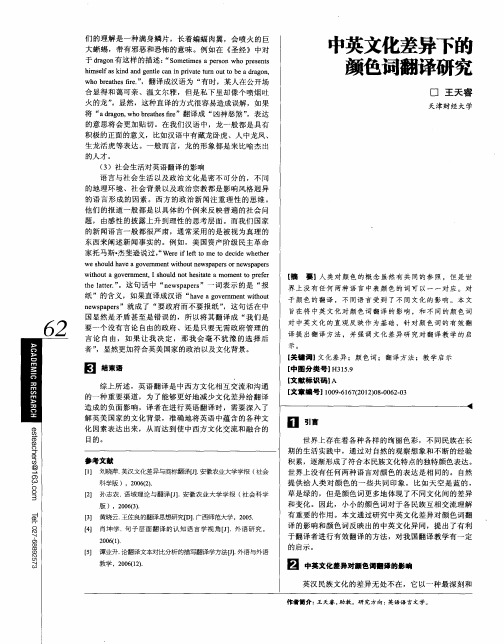
6 要一个 没有言论 自由的政府,那 我 会毫 不犹 豫 的选 择 后 2 言 论 自由,如 果让 我 决定 、还是只要 无需政府管 理的
者” ,显然更加符合英美 国家 的政 作 为基 础 ,针 对颜色 词的有效番
译提 出翻译方 法,并强调 文化差异 研究对翻译 教学 的启
界 上 没 有 任 何 两 种 语 言 中表 颜 色 的 词 可 以 一 一 对 应 。 刘 于 颜 色 的 翻 译 , 不 同语 言 受 到 了不 同 文 化 的 影 响 。 本 文
国显然 是矛盾甚 至是错误 的,所 以将其翻 译成 “ 我们是
旨在 将 中英 文 化 对 颜 色 词 翻 译 的影 响 ,和 不 同 的 颜 色
【 摘
耍 1 类 对 颜 色 的概 念 虽 然 有 共 同 的参 照 ,但 是 人
telt r 0这 句话 中 “ e sa es h a e. t ” n w pp r”一词表 示 的是 “ 报 纸 ”的 含 义 ,如 果 直 译 成 汉 语 “ aeagvrmet i ot hv oen n t u wh nwsa es e pp r”就成 了 “ 政府而不要 报纸 ” 要 ,这句话 在 中
草 是 绿 的 , 但 是 颜 色 词 更 多 地 体 现 了不 同 文 化 间 的 差 异
参考 文 献
[】 刘晓 萍. 汉文化 差异 与商 标翻 译 [ l 1 英 J 安徽 农 业大 学学 报 ( 会 】 社 科学 版 ),20 () 062. [】 孙 志 农 . 域 理 论 与 翻 译 [] 2 语 J.安徽 农 业 大 学 学 报 ( 会 科 学 社
版 ),2 0() 063. [] 黄晓云. 3 3 王佐 良的翻译思想研究【 . D】广西师范大学,2 0 . 05
英汉词汇不对等的例子英汉翻译中词汇的不对等性及其翻译策略
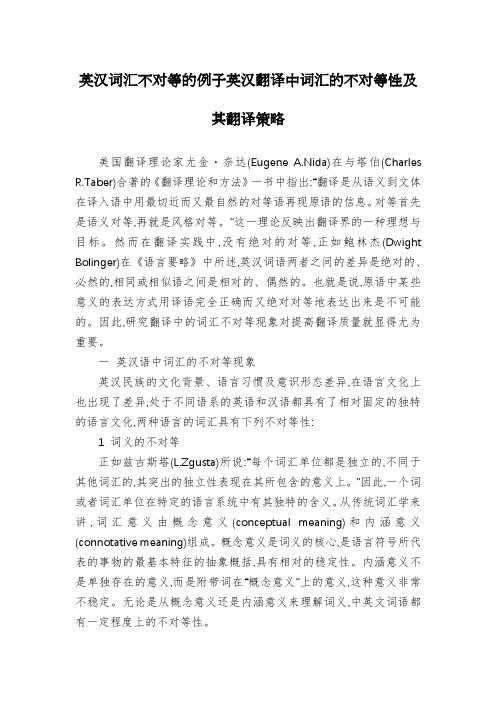
英汉词汇不对等的例子英汉翻译中词汇的不对等性及其翻译策略美国翻译理论家尤金・奈达(Eugene A.Nida)在与塔伯(Charles R.Taber)合著的《翻译理论和方法》一书中指出:“翻译是从语义到文体在译入语中用最切近而又最自然的对等语再现原语的信息。
对等首先是语义对等,再就是风格对等。
”这一理论反映出翻译界的一种理想与目标。
然而在翻译实践中,没有绝对的对等,正如鲍林杰(Dwight Bolinger)在《语言要略》中所述,英汉词语两者之间的差异是绝对的、必然的,相同或相似语之间是相对的、偶然的。
也就是说,原语中某些意义的表达方式用译语完全正确而又绝对对等地表达出来是不可能的。
因此,研究翻译中的词汇不对等现象对提高翻译质量就显得尤为重要。
一英汉语中词汇的不对等现象英汉民族的文化背景、语言习惯及意识形态差异,在语言文化上也出现了差异,处于不同语系的英语和汉语都具有了相对固定的独特的语言文化,两种语言的词汇具有下列不对等性:1 词义的不对等正如兹古斯塔(L.Zgusta)所说:“每个词汇单位都是独立的,不同于其他词汇的,其突出的独立性表现在其所包含的意义上。
”因此,一个词或者词汇单位在特定的语言系统中有其独特的含义。
从传统词汇学来讲,词汇意义由概念意义(conceptual meaning)和内涵意义(connotative meaning)组成。
概念意义是词义的核心,是语言符号所代表的事物的最基本特征的抽象概括,具有相对的稳定性。
内涵意义不是单独存在的意义,而是附带词在“概念意义”上的意义,这种意义非常不稳定。
无论是从概念意义还是内涵意义来理解词义,中英文词语都有一定程度上的不对等性。
2 概念意义的不对等在中英文中有的词汇概念意义是不对等的,如中英文在称谓上的词汇就不完全对等。
汉语中的称谓讲究:长幼有序,内外有别,男女有别。
而英语中的称谓基本上只进行性别的区分。
如汉语中的“伯父”、“叔父”、“姑父”、“姨夫”、“舅舅”等,在英语中只有uncle一词来统指父系尊长,aunt表示母系尊长,sister 表示姐姐或妹妹,brother指哥哥或弟弟。
对英汉颜色词汇翻译方法的研究
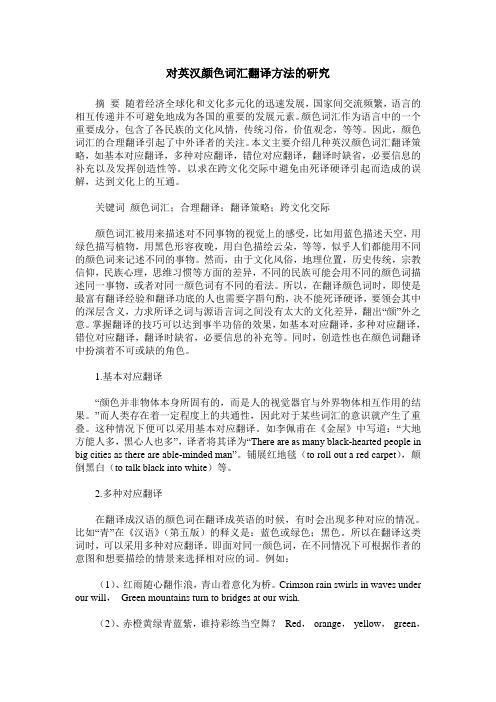
对英汉颜色词汇翻译方法的研究摘要随着经济全球化和文化多元化的迅速发展,国家间交流频繁,语言的相互传递并不可避免地成为各国的重要的发展元素。
颜色词汇作为语言中的一个重要成分,包含了各民族的文化风情,传统习俗,价值观念,等等。
因此,颜色词汇的合理翻译引起了中外译者的关注。
本文主要介绍几种英汉颜色词汇翻译策略,如基本对应翻译,多种对应翻译,错位对应翻译,翻译时缺省,必要信息的补充以及发挥创造性等。
以求在跨文化交际中避免由死译硬译引起而造成的误解,达到文化上的互通。
关键词颜色词汇;合理翻译;翻译策略;跨文化交际颜色词汇被用来描述对不同事物的视觉上的感受,比如用蓝色描述天空,用绿色描写植物,用黑色形容夜晚,用白色描绘云朵,等等,似乎人们都能用不同的颜色词来记述不同的事物。
然而,由于文化风俗,地理位置,历史传统,宗教信仰,民族心理,思维习惯等方面的差异,不同的民族可能会用不同的颜色词描述同一事物,或者对同一颜色词有不同的看法。
所以,在翻译颜色词时,即使是最富有翻译经验和翻译功底的人也需要字斟句酌,决不能死译硬译,要领会其中的深层含义,力求所译之词与源语言词之间没有太大的文化差异,翻出“颜”外之意。
掌握翻译的技巧可以达到事半功倍的效果,如基本对应翻译,多种对应翻译,错位对应翻译,翻译时缺省,必要信息的补充等。
同时,创造性也在颜色词翻译中扮演着不可或缺的角色。
1.基本对应翻译“颜色并非物体本身所固有的,而是人的视觉器官与外界物体相互作用的结果。
”而人类存在着一定程度上的共通性,因此对于某些词汇的意识就产生了重叠。
这种情况下便可以采用基本对应翻译。
如李佩甫在《金屋》中写道:“大地方能人多,黑心人也多”,译者将其译为“There are as many black-hearted people in big cities as there are able-minded man”。
铺展红地毯(to roll out a red carpet),颠倒黑白(to talk black into white)等。
颜色词汇的英汉互译策略
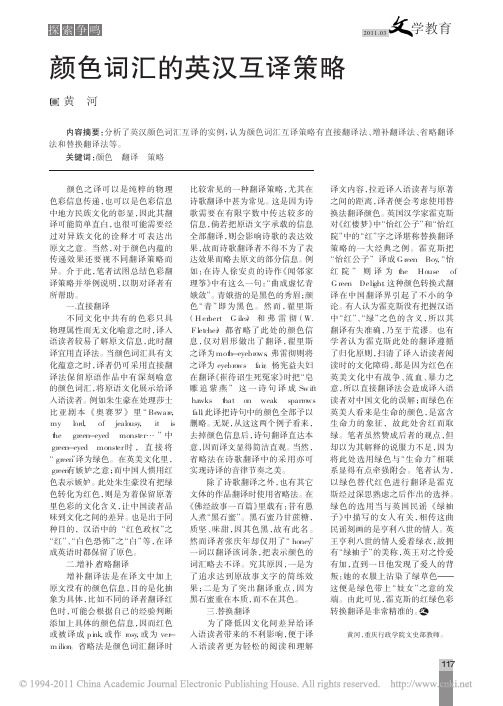
除了诗歌翻译之外,也有其它 文体的作品翻译时使用省略法。在 《佛经故事一百篇》里载有:昔有愚 人煮“黑石蜜”。黑石蜜乃甘蔗糖, 质 坚 、味 甜 ,因 其 色 黑 ,故 有 此 名 。 然而译者张庆年却仅用了“honey” 一词以翻译该词条,把表示颜色的 词汇略去不译。究其原因,一是为 了追求达到原故事文字的简练效 果 ;二 是 为 了 突 出 翻 译 重 点 ,因 为 黑石蜜重在本质,而不在其色。
黄河,重庆行政学院文史部教师。
117
探索争鸣
2011.03
学教育
浅论汉译英时颜色词的不对应性

浅论汉译英时颜色词的不对应性[摘要]颜色词不仅反映着色彩的物理属性,还具有多种多样的象征意义和引申意义,由于使用不同语言的民族具有各自不同的文化特征,同样的颜色词在汉语和英语中可能对应着不同的意义,因而在汉译英时往往不能对等翻译。
本文对红、青、白、黑四种基本颜色在汉译英时的不对应性进行了探讨。
[关键词]汉译英颜色词不对应性从反映的色彩的物理属性来看,汉英颜色词的基本意义是一致的,但是由于各民族在长期的历史发展过程中积淀了不同的生理、心理和文化的特征,因而同样的颜色词在不同民族中所代表的意义也有所差异,这种差异是引起文化含义误解和语用意义混淆的重要原因。
以下仅从红、青、白、黑四种基本颜色在汉语和英语中的不对应性来作一探讨。
(一)红色从表现的物理属性来看,英语和汉语中的“红色”是基本对应的,如“红星”(red star),“红叶”(red autumnal leave),“红豆”(red bean)等。
但是中国哲学讲求“虚”,注重“神似”,而西方哲学讲“实”,注重科学精确,这种文化气质也反映在颜色词中。
如“红糖”体现了红色在汉文化中的重要影响,红色是喜庆、吉祥和红火的象征,而且中国妇女在生产之后有用红糖来补血养身的传统,因此中国人乐于称之为“红糖”。
然而从物理学角度来讲,这种糖的颜色更接近棕色,因此英语中定名为“Brown sugar ”显得更加准确。
再如“红烧肉”实际上是用酱油烧制而成,并非是真正的“红色的肉”,英语中用“pork braised in brown sauce”更接近于真实。
还有英语的“black tea”意为汉语中的“红茶”,其实这种茶颜色深浓而更近于黑色。
汉语和英语中红色的不对应性更多地是表现在词语的语用涵义上。
如“红娘”是《西厢记》里女主角崔莺莺的侍女,她促成了莺莺和男主角张生的结合,后来民间便称热心促成别人姻缘的人为“红娘”,译为英语应是“match—maker”。
汉语中“ 红颜”是指年轻貌美的女子,应译为“beautiful woman”;“红白喜事”中的“红”和“白”分别象征婚礼和葬礼,对应的英语为“weddings and funerals”。
翻译策略:再议汉英颜色词汇不对应问题及其翻译策略

再议汉英颜色词汇不对应问题及其翻译策略一、引言英汉之间存在各种层面的不对应问题。
这些问题主要由两种语言的产生和发展的背景不同造成的。
一般情况的不对应采用相应的意译基本可以解决。
但是颜色词汇在应用中的不对应却不能简单的用某种方法来解决。
二、颜色词的不对应颜色识时务的一个重要属性,人们对颜色的认知也是最早最基本的。
虽然对于颜色的看法是完全一致的,但是由于不同的民族风俗文化、历史传统、宗教信仰、思维方式等方面的差异,导致了对颜色的象征意义完全不同的现象,这就是本文要研究的颜色词不对应现象。
这些颜色词意义上的不对应主要存在于以下两个方面:首先,文化内涵上的不对应。
在汉语中,由于中国历史和政治的发展,红色在汉文化中起着很重要的作用,拥有深刻的文化内涵。
这一颜色被广泛用来表达喜庆、成功等含义。
并且由于这个词的这种含义,很多相近的颜色也被称为红色。
例如红糖、红茶,而这两种东西的颜色其实并不是红色,而英语用更准确的颜色来表达,brown sugar和black tea。
但是在汉语中,红糖,红茶是和白糖,绿茶相对应而取的名字,如果我们把红糖和红茶叫做棕糖和黑茶,估计没有人回去喝他们了。
在汉语古诗词里,颜色词常带有很大的模糊性,经常“变色”。
如通常我们把“青”、“苍”、“碧”、“绿”四色对应地英译为“blue”、“grey”、“bluish—green”、“green”。
但在不少诗文中,根据语境和作者的表达方式,这几种颜色的"本色"却另有所指。
如:(1)《尚书•禹贡》“厥土青黎”和李白《将进酒》“朝如青丝暮成雪|中的”青“,皆非蓝色或绿色,而是”black“(黑色);(2)《诗经•秦风•黄乌》”彼苍者天”杜甫《述怀》“摧颓苍松根”中之“苍”也不是灰色,跟“grey”是不对等的;(3)温庭筠《瑶瑟怨》“碧天如水夜云轻”和江淹《拟休上人诗》“日暮碧云合”中的“碧天”、“碧云”自然不可能是“绿天”、“绿云”;(4)杜牧《阿房宫赋》“绿云扰扰,梳晓鬟也”中的“绿云”指女子美丽乌黑的头发。
中英颜色论文

II.The Factors Causing Cultural Differences between English and Chinese Color Words
1. Natural Environments and Historical Backgrounds
we know the weather of England is always warm and the wool spinning industry has developed rapidly in England and from early time.Thereby,English people often use sheep wool as analogue.For example,there is wool so white but a dyer call make it black(羊毛虽白,染之则黑).when westerners hold a wedding,the bride dress white marriage ceremonial dress,which stands for chastity and pure ,but Chinese bride dress red clothes,which stands for happiness and auspice from ancient times.In china,festival couplets must be written in red paper; lanterns hanging under eaves must be made of red paper.
Cultural Differences and Translation in Chinese and English Color words
英语毕业论文颜色词的中英文文化差异

英语毕业论文颜色词的中英文文化差异Cultural Differences of Chinese and English Color WordsABSTRACTLanguage is a kind of social phenomenon and is the carrier of culture. Almost every language has color words, including Chinese and English. However, the words to describe colors differ from one language to another because of different customs, polities, religious beliefs etc. Different colors bring different symbolic meanings which have unique characteristics in each nation. As a result, it may lead to misunderstanding and even violate the taboos. The main purpose of this paper is to compare the differences between Chinese and English color words in terms of word building, history, politics, economy and daily usage to help people to have a better understanding of different cultures and to bridge the gap between different cultures in communication and to facilitate cultural exchange.Keywords: color word culture differences politics history daily usage颜色词的中英文文化差异摘要语言是一种社会现象,也是文化的载体。
浅议英汉双语中颜色词翻译的不对等性

浅议英汉双语中颜色词翻译的不对等性颜色词是我们生活中不可缺少的色彩,其中也蕴含着各民族不同文化的内涵。
在英汉颜色词翻译中,有时颜色词的字面意义和比喻意义并不完全对等,差异会很大。
了解英汉双语中颜色词的翻译差异,有助于译者进行有效翻译,避免出现断章取义、交际失败的错误。
语言是文化的载体,与文化息息相关。
词汇除了字面意义之外,还有文化、传统和感情的成分,使其所产生的联想意义与原始疑义相差很大,给译者的翻译变得很难。
颜色词是我们日常生活中最显而易见的,而这种最常见的颜色词的英汉翻译有时也并非一件容易的事。
本文就黑、白、红、黄、绿五种基本颜色词的英汉翻译进行分析,阐述英汉双语中颜色词的概念意义和内涵意义的不对等性,使读者对语言和文化之间的千丝万缕的联系有个大致的了解,避免在跨文化交际中出现失误。
一、黑与black英语中black的用法有时在汉语里找不到与之相对应的意思。
如:I could feel blood draining from my face.I wondered whether I was about to black out.我能感到血从脸上淌下来。
我不知道自己是不是要昏过去了。
句中black out指暂时“失去知觉”和黑色没有什么关系。
black sheep 从字面上看是“黑色的绵羊”,可实际上是“败家子、害群之马”之意;a black day 是指“倒霉的一天”而不是“黑色的一天”;我们常说中国人是黄皮肤,黑眼睛但翻译是却不能用black eye,因为这是“丢脸”之意而不是“黑色的眼睛”。
汉语中的“黑”有时也不能用black来表达。
如:黑暗是dark;黑社会是underworld;黑客是hacker;黑话是argot;黑心是evil mind ;黑幕是inside story。
二、红色与red红色在英语中也有象征庆祝、隆重和喜庆的日子。
a red letter day指纪念日、喜庆日、特别重要的日子;to paint the town red指狂欢作乐;red cent指很少的钱;red tape指繁文缛节、繁琐的程序。
中英文中颜色词的联想意义的对比以及颜色词的翻译【文献综述】

文献综述英语中英文中颜色词的联想意义的对比以及颜色词的翻译一、前言部分(说明写作的目的,介绍有关概念,扼要说明有关主题争论焦点)1.写作目的:众所周知,颜色词在人们的生活与交流过程中起着重要的作用。
影响红色联想意义的因素有很多,比如历史因素,社会心理因素,宗教因素等等。
本文主要研究红色在中英文中联想意义的对比及其翻译手段。
通过阅读文献,列出常见的一些引起红色联想意义不同的因素,同时分析红色在不同情境下应使用的翻译手段,最后提出一些建议,希望能对外语学习者的外语学习及外语教师的教学提供一些启迪。
2.相关概念:徐芳(2008)在《汉英“红色”词汇的语义对比研究》中说,颜色词是人类的色彩认知能力对客观世界中颜色认知、范畴化和编码的结果。
杰弗里.利奇(leech)认为,语义只是意义的一部分,是词或词组的认识意义或者概念意义,也就是他们最基本的核心意义。
陈强(2003)在《汉英动、植物词和颜色词联想意义的差异及其原因》中说,联想意义是人们语言使用过程中,在特定的语用环境下对某一个词产生的附加意义。
这种附加意义体现词汇的感情色彩意义、搭配意义和内涵意义等。
章志光写的《社会心理学》(2008)中提出:社会心理是指一定社会生活状况下形成的、互有影响的多数人共有的心理现象。
王松兰(2010)在《谈英语习语翻译中的直译法》中指出,采用直译法翻译英语习语,是在不违背汉语译文语言规范的前提下,将英语习语按照英文的字面意思直译过来。
平丽芳(2006)在《从“lose one's shirt”谈英语习语翻译的意译法》中,她强调了所谓意译法就是用不同于原文的表达形式来表达与原文相同的思想内容的方法。
3.争论焦点:在过去很长一段时间内,颜色词研究的重点一直集中在大致研究上,虽然基本上都有文献对每种颜色在中英文中的对应意义进行解释,但对各个颜色的深入探讨并没有与时俱进并且提高。
人们逐渐认识到颜色词出现在生活中的频率增加,与自己的生活与交流息息相关。
颜色词在英汉互译中的不对应性探析
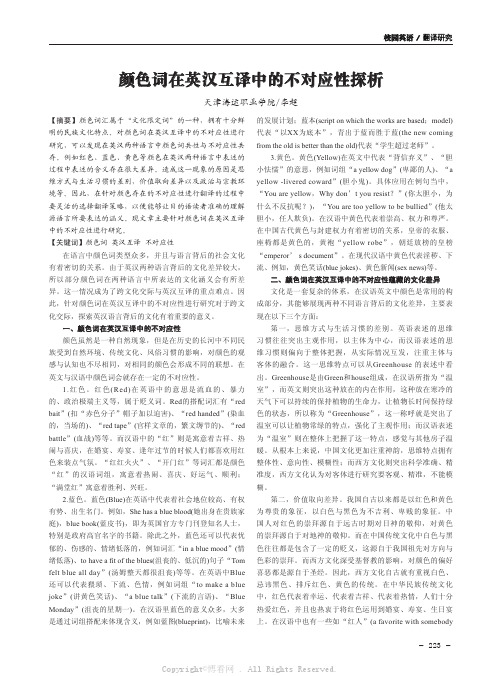
- 223 -校园英语 / 翻译研究【摘要】颜色词汇属于“文化限定词”的一种,拥有十分鲜明的民族文化特点。
对颜色词在英汉互译中的不对应性进行研究,可以发现在英汉两种语言中颜色词共性与不对应性共存。
例如红色、蓝色、黄色等颜色在英汉两种语言中表述的过程中表述的含义存在很大差异。
造成这一现象的原因是思维方式与生活习惯的差别,价值取向差异以及政治与宗教环境等。
因此,在针对颜色存在的不对应性进行翻译的过程中要灵活的选择翻译策略,以便能够让目的语读者准确的理解源语言所要表达的涵义。
现文章主要针对颜色词在英汉互译中的不对应性进行研究。
【关键词】颜色词 英汉互译 不对应性在语言中颜色词类型众多,并且与语言背后的社会文化有着密切的关系。
由于英汉两种语言背后的文化差异较大,所以部分颜色词在两种语言中所表达的文化涵义会有所差异。
这一情况成为了跨文化交际与英汉互译的重点难点。
因此,针对颜色词在英汉互译中的不对应性进行研究对于跨文化交际,探索英汉语言背后的文化有着重要的意义。
一、颜色词在英汉互译中的不对应性颜色虽然是一种自然现象,但是在历史的长河中不同民族受到自然环境、传统文化、风俗习惯的影响,对颜色的观感与认知也不尽相同,对相同的颜色会形成不同的联想。
在英文与汉语中颜色词会就存在一定的不对应性。
1.红色。
红色(Red)在英语中的意思是流血的、暴力的、政治极端主义等,属于贬义词。
Red 的搭配词汇有“red bait ”(扣“赤色分子”帽子加以迫害)、“red handed ”(染血的,当场的)、“red tape ”(官样文章的,繁文缛节的)、“red battle ”(血战)等等。
而汉语中的“红”则是寓意着吉祥、热闹与喜庆,在婚宴、寿宴、逢年过节的时候人们都喜欢用红色来装点气氛。
“红红火火”、“开门红”等词汇都是颜色“红”的汉语词组,寓意着热闹、喜庆、好运气、顺利;“满堂红”寓意着胜利、兴旺。
2.蓝色。
蓝色(Blue)在英语中代表着社会地位较高、有权有势、出生名门。
浅谈英汉颜色的文化差异及翻译对策

分类 电话簿 , 并非“ 淫秽书刊”这 与汉语 ,
文 化 中 的联 想 意 义 有 天 壤 之 别 。 eO UW
家 P u K y在 《 本颜色 词语 : al a 基 普遍性
与 进 化 论 研 究 》 B rn & K v 9 1 ( el i a 19
有 着 不 同的 文化 内涵 和延 伸 意 义 , 此
异, 不能望文生义 , 简单地将其理解 成相
对 应 的汉语 颜 色 词 。 当前英语教 学普遍存在 的问题是 : 在 重 视 语 言 知 识 教 学 的 同 时 ,忽 视 了文
b r i tep rl( 于帝 王之 家 ) o n h u e 生 n p 。
人 们 对 色 彩 的视 觉 感 是 相 同 的 , 英 语 和 汉语 对 基 本 颜 色 词 的分 类 差 别 也 不 大 。美 国 民俗学 家 BetB r 异 .
由于 历 史 文 化 传 统 的 不 同 ,英 汉 两 种 语 言 中颜 色 词 的 引 申 意 义 有 较 大 差 异 , 影 响跨 文化 交 际 的 因素 之 一 。 是
2 0 .0( 0 9 1 总¥5 1 ) o
… … … … 一 … … … … … … … … … 一 … … 一 … … … … … … … ’ … 一 … … … 一 … … … ● 一 ● … ● … _ … … … … ●… -…
刘 信 波 唐 博
颜 色是人们 对客观世界 的感知 , 是
语 课 的 目的 之一 在 于培 养 学 生 跨 文 化 交
际 (n ru ua c m u i t n 的 能 力 。 It c l r o m n a o ) e t l ci
对联 、 发红包 、 派红利 、 挂大红灯笼 、 传统
中英文化差异下的颜色词翻译研究

中英文化差异下的颜色词翻译研究一、本文概述语言是文化的载体,而翻译作为跨文化交流的重要方式,在中英文化的交流与理解方面起着关键作用。
颜色词作为语言中不可或缺的一部分,其翻译受到文化差异的深刻影响。
本文旨在探讨中英文化差异下的颜色词翻译研究。
本文将介绍中英文化中颜色词的翻译差异。
由于社会习俗、历史文化、地理环境、思维习惯和宗教信仰等因素的影响,中英颜色词的翻译存在着许多差异。
例如,汉语中的“青”可以表示蓝色或绿色,而英语中的“blue”只能表示蓝色。
颜色词在中英文化中还具有特定的文化内涵,如汉语中的“红”常与喜庆、吉祥相关联,而英语中的“red”则可能与危险、愤怒相联系。
本文将探讨中英颜色词翻译的挑战和解决方法。
由于颜色词的翻译不仅涉及语言的转换,还涉及文化的理解和传达,因此译者在进行颜色词翻译时需要深入了解中英文化的内涵,并灵活运用翻译技巧。
例如,对于没有直接对应词汇的颜色词,译者需要根据上下文信息和其他词汇来传达原文的意思。
本文将讨论中英颜色词翻译研究的意义和启示。
了解中英颜色词翻译的差异对于跨文化交流具有重要意义,可以帮助我们更好地理解和欣赏不同文化的独特魅力。
同时,对于语言学习者和翻译工作者来说,掌握颜色词的翻译技巧也有助于提高语言表达的准确性和文化适应性。
本文将从文化差异的角度出发,对中英颜色词的翻译进行深入研究,以期为跨文化交流和语言学习提供有益的参考。
二、中英文化差异概述中英文化在许多方面都存在着差异,这些差异不仅体现在语言上,还体现在思维方式、价值观、社会习俗等方面。
美学观念的差异:中国文化讲究美学,追求虚无、逍遥和飘逸的境界,这种美学观念可以追溯到《诗经》的风格。
例如,风在中国文化中象征着自由和飘逸。
而英国文化则注重幽默,但这种幽默并非无厘头式的搞笑,而是具有深度和回味的幽默。
社交礼仪的差异:在中国,握手是最常见的见面礼节,拥抱则较为少见,通常只限于多年未见的老朋友或亲人之间。
而在英国,握手和拥抱都是常见的问候方式,亲吻脸颊也是朋友间常见的打招呼方式。
论文最新-英汉互译中颜色词的非对应翻译策略研究

A Study of E-C Color Term Corresponding Translation Strategies英汉互译中颜色词的非对应翻译策略研究Abstract and Key WordsAbstract:Language is the reflection of culture. English and Chinese exist in two different cultures, and has its own history and society, living environmentand experiences, customs and religions, and so on. However, all of thesefactors result in the different associative meanings in same vocabulary ordifferent words, in other words, the culture-loaded words. In western andChinese societies, there are many words or phrases with same wordmeaning but different associative meanings which caused by culturaldifferences. In fact, the differences in associative meaning is actually thegap between cultural information. As people live in different environmentswith different cultural background and customs, for the same object orthing, they usually have different associations. This paper analyzes theinfluence of cultural difference on color associative meanings and itstranslation from perspective of vocabulary, through comparative analysison associative meaning differences in Chinese and western cultures and theinfluences in translation, this paper points out the importance of culturaldifferences in associative meanings and translation and thus put forwardsome translation methods for solving these problems in culture-loadedword translation.Key words: comparative analysis; basic color terms; cultural connotations; differences; reasons摘要:语言是文化的反映。
(英语毕业论文)英汉颜色词汇的文化差异及其翻译

2016年最新全英原创毕业论文,都是近期写作1 透过《马丁伊登》看杰克伦敦对超人哲学的矛盾心态2 小学英语教学中的体态语应用3 A Study of Hawthorne’s Notion of Science as Shown in “Rappaccini's Daughter”4 解析《莎乐美》中的月亮意象5 《了不起的盖茨比》中女性人物性格分析6 师生关系与学生英语学习积极性之关联性探析7 初中英语课堂教学师生互动有效性研究8 谭恩美《灶神之妻》文化解读9 简析黑人英语的主要特征及其文化影响10 论《海上扁舟》中的美国自然主义11 目的论指导下的导游词英译策略研究12 浅谈导游词翻译13 浅析《老人与海》中的悲剧色彩14 文档所公布均英语专业全英原创毕业论文。
原创⑧ 0 ⑤⑨⑨ 0⑦④⑨15 交际式语言测试在初中英语课堂中的应用16 文化语境维度下中餐菜名的英译研究17 初中英语词汇教学的有效方法18 从跨文化交际的发展看西方饮食文化对中国饮食文化的影响19 An Archetypal Study of J.D.Salinger’s The Catcher in the Rye20 《宠儿》的黑人女性主义解读21 从三美原则看中国古诗词中酒意象的英译22 谈双关语的翻译23 中美学生对待教师的礼貌言行的对比分析24 分析内战对《飘》中斯佳丽的影响25 研究简奥斯汀的婚姻观---根据分析她的著作《傲慢与偏见》26 英汉语篇衔接手段对比研究——以《荷塘月色》英译本为例27 中餐菜名英译中的文化亏损现象探析28 A Tentative Analysis of the Reasons for McDonald’s Success29 《基督山伯爵》与亚历山大大仲马的金钱观30 中国和英国传统婚俗差异研究31 透过《傲慢与偏见》论简奥斯丁的婚姻观32 《浮生六记》翻译赏析—林语堂翻译策略研究33 凯特肖邦作品中女性自我意识觉醒的主题研究34 《玻璃动物园》中的逃避主义解读35 中西饮食文化及其差异36 An Analysis on Shear's Personality in The Bridge on the River Kwai37 从电影《刮痧》看东西方文化差异38 Discourse Analysis on the Translation of Person of the Year, an Editorial in the Time Magazine39 从E.B.怀特与秦文君的儿童文学作品看中西方价值观之比较40 希腊神话在占星学中的体现41 约翰斯坦贝克《人鼠之间》的种族主义分析42 论《爱玛》中简奥斯丁的女性主义观43 政论文的英译特点44 从《了不起的盖茨比》看菲茨杰拉德的女性观45 试论中学英语教育中师生关系模式的构建46 哈克贝利费恩对“文明世界”的适应47 《玻璃动物园》中的逃避主义解读48 论《都柏林人》中的情感瘫痪49 中英动物习语的跨文化分析50 消除不良商标翻译的策略51 从文化的角度理解《喜福会》中的母女关系52 An Analysis of Life and Death in Mrs. Dalloway53 试论美国第二代女权主义54 《红字》中丁梅斯代尔的灵魂救赎55 xx大学影视英语教学调查56 《魔戒》中的现实主义初探57 从谈判风格看中美文化差异58 从《红字》看霍桑的政治观59 论《推销员之死》基于传统希腊悲剧的发展60 大学英语电影教学现状及对策分析61 论《红字》中的清教主义思想62 A Comparison between Chinese and Western Food Cultures63 从谭恩美小说中“家”的概念看其文化身份认定64 中西婚姻文化差异65 浅析跨映射视角下的歇后语意义构建66 《飘》—斯嘉丽女性主义意识的成长历程解读67 素质教育下农村小学英语现状初探--以某县为例68 违反合作原则下的幽默效果69 文化差异对商标翻译的影响及翻译策略70 英语委婉语的认知分析71 从会话含义角度解读《老友记》的言语幽默效果72 论中美广告伦理观的差异——从“性感平面广告”中的女性形象分析73 Living in the Crack: A Study of the Grotesques in Winesburg, Ohio74 《吉姆老爷》中吉姆的性格分析75 Cultural Influences on Business Negotiation between China and Japan76 从婚礼仪式浅谈中西方文化的冲突和交融77 电影名称的翻译特点78 被忽略的人群--詹姆斯乔伊斯《都柏林人》女性角色分析79 An Analysis of Harriet Beecher Stowe’s View on Christianity in Uncle Tom’s Cabin80 对高中学生英语学习动机现状及激发策略的调查分析—以屏边高级中学为例81 A Comparison of the English Color Terms82 通过阅读提高大学生的英语写作能力83 从目的论角度浅析《阿甘正传》字幕翻译84 中美商务谈判的风格差异85 On Classification of Chinese Dish Names and Their Translation Strategies86 A Study on Developing Autonomous Learning Ability of Junior High School Students87 简析《卡斯特桥市长》中亨查德的悲剧命运88 探析《最蓝的眼睛》中女主人公的悲剧根源89 A Research on Frances Burnett’s “Fauntleroy” Writing Style90 莎士比亚《仲夏夜之梦》中的男性探究91 《隐形人》中主人公的性格分析92 An Analysis of Vanity Fair from the Perspective of Interpersonal Function93 女性主义视角下《傲慢与偏见》的情态意义解读94 A Comparison of the English Color Terms95 A Script-based Study of the Female Theme in Scent of a Woman96 A Comparison of the English Color Terms97 英语中的性别歧视98 男权社会女性意识的觉醒——弗吉尼亚·伍尔夫女性主义文学研究99 从女性主义视角看《蝴蝶梦》100 外贸英文函电中委婉语的特点及应用研究101 语境与商务英语信函写作102 《飘》中斯嘉丽的主要性格特征浅析103 科技英语长句的结构分析与翻译104 英语学习中语法的功能105 论修辞在英语广告中的应用106 中西性教育方式对比折射中西文化差异的研究107 从语用学视角初步分析英语骂詈语108 从宝洁公司的运营模式看美国文化的多样性109 浅析叶芝诗歌中的象征主义特征110 海丝特白兰—清教时代的新女性111 从电视相亲节目看当代中美女性婚恋观差异112 从《雾都孤儿》看查尔斯狄更斯的善恶观113 考琳麦卡洛《荆棘鸟》中麦琪悲剧命运的成因114 新闻英语文体分析115 论杜鲁门卡波特《蒂凡尼的早餐》中霍莉的漂泊人生116 旅游广告资料翻译探讨117 功能对等理论视角下《越狱》字幕翻译的研究118 英语广告语中的隐喻认知119 伊丽莎白班内特和姚木兰的比较研究120 《道连·格雷的画像》中意识与潜意识的对抗与结合121 论《红字》中的博爱精神122 浅析《小妇人》中乔的女性意识及其成长过程123 论“迷惘的一代”--以海明威为个案124 女性意识的苏醒--对《愤怒的葡萄》中的约德妈妈形象的分析125 从合作原则看《白象似的群山》中的对话126 女性主义视角下《白象似的群山》与《莳萝泡菜》中男性形象的对比研究127 A Comparison of the English Color Terms128 肢体语言在商务谈判中的应用与作用129 论跨文化交际中的中西文化冲突130 解析《永别了,武器》中亨利的人物形象131 中西方寒暄语简要对比研究132 A Comparison of the English Color Terms133 青少年的危机时刻——短篇小说集《最初的爱情,最后的仪式》初探134 目的论在英语儿歌翻译中的应用135 论高中英语写作教学中的文化意识培养136 以“三美论”对比《登高》两个英译版本的“意美”与“音美”137 论罗伯特佩恩沃伦《国王的人马》中对真理与自我认知的追求138 析《苔丝》中的象征意义139 《爱玛》的婚姻观分析140 从文化角度分析《穿普拉达的恶魔》所反映的职业观141 浅析中学生英语学习中的情感因数142 从生态女性主义视角解析托尼莫里森的《宠儿》143 Politeness and Its Manifestation in Business Correspondence144 The Death Image of Emily Dickinson’s Poetry145 凯瑟琳曼斯菲尔德《园会》和《一杯茶》中的异化146 以《生活大爆炸》为例从言语行为理论角度分析美剧中的双关语147 消费文化社会下嘉莉的生存斗争148 任务型语言教学在高中英语课堂中的应用149 朗读在中学英语教学中的作用150 论概念隐喻视角下的隐喻翻译151 英语频度副词“ALWAYS”主观性嬗变的历时研究152 Analysis of Gone with the wind from the Perspective of Feminism153 《劝导》中安妮艾略特的道德判断154 商务谈判中的中西文化差异及其对策155 从《看不见的人》中看黑人对自我身份的追求和探寻156 美国犹太文化与传统犹太文化的冲突——浅析《再见吧,哥伦布》157 苔丝和傲慢与偏见中的女性意识之对比研究158 An Analysis of the Initiation Theme in The Child in Time159 霍桑的矛盾心理及其体现在《红字》中的对比描写160 《汤姆叔叔的小屋》中圣克莱尔一家的人物分析161 从《所罗门之歌》看美国的黑人文化162 从跨文化交际角度看《贵妇画像》中的文化冲突163 影响英语专业学生阅读理解因素的分析及对策探讨164 合作学习法对英语口语能力的影响——对独立学院非英语专业学生的个案研究165 流行美剧《生活大爆炸》字幕翻译研究166 分析《简爱》和《名利场》中的女性主义167 从商业性角度论电影名称的翻译168 From Dormancy to Revival—A Feminist Study on Kate Chopin’s Awakening169 从冗余理论浅谈翻译技巧之增译法与减译法170 The Loss and Gain in Classical Chinese Poetry Translation171 浅谈中西文化差异172 《傲慢与偏见》中女性话语的言语行为理论分析173 从思维模式看中西方文化差异174 从生态学角度解读《白鲸》175 初中英语教学中教师课堂用语的构建与应用176 情景教学法在中学英语写作教学中的应用177 《纯真年代》女性意识探析178 A Comparison of the English Color Terms179 从奈达的功能对等看句式转换在《青铜女像》译本中的应用180 《推销员之死》中的家庭问题研究181 群体隐私和个体隐私——中美家庭中隐私观念的对比研究182 浅析电影《勇敢的心》中的英雄主义183 商务谈判中话语的顺应性研究184 英汉味觉词“酸甜苦辣”的比较分析185 英语流行歌曲中隐喻的功能分析——以后街男孩的歌曲为例186 小说《飘》中斯嘉丽的人物性格分析187 瓦尔登湖畔的隐士:反抗与变革188 《那个读伏尔泰的人》英译汉中定语从句的翻译策略189 Improving Senior High School Students’ Oral English by Applying English Songs 190 流行语的翻译191 从语用等效角度透析旅游景点名称英译192193 论企业国际化中的品牌翻译开题报告+论文( )194 从高校课桌文化透视当代大学生的内心压力195 试析新课程标准下词汇教学策略的改变196 从成长小说角度解读《马丁伊登》197 精神的抗拒与皈依--浅析奥康纳《智血》中的信仰异化198 从苔丝和曼桢的角色分析中西文化下女性的抗争199 汉英习语翻译中的文化意蕴对比分析200 商标翻译中的文化因素探析。
(英语毕业论文)中英颜色词的翻译和比较
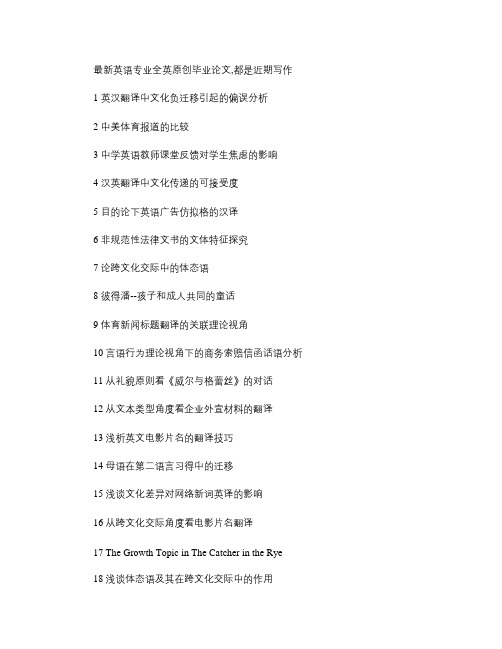
最新英语专业全英原创毕业论文,都是近期写作1 英汉翻译中文化负迁移引起的偏误分析2 中美体育报道的比较3 中学英语教师课堂反馈对学生焦虑的影响4 汉英翻译中文化传递的可接受度5 目的论下英语广告仿拟格的汉译6 非规范性法律文书的文体特征探究7 论跨文化交际中的体态语8 彼得潘--孩子和成人共同的童话9 体育新闻标题翻译的关联理论视角10 言语行为理论视角下的商务索赔信函话语分析11 从礼貌原则看《威尔与格蕾丝》的对话12 从文本类型角度看企业外宣材料的翻译13 浅析英文电影片名的翻译技巧14 母语在第二语言习得中的迁移15 浅谈文化差异对网络新词英译的影响16 从跨文化交际角度看电影片名翻译17 The Growth Topic in The Catcher in the Rye18 浅谈体态语及其在跨文化交际中的作用19 英语教学中合作学习策略的初步研究20 中国英语学习者在词汇方面的迁移21 解读《纯真年代》中的爱伦的悲剧原因22 论《麦田里的守望者》的意义23 《美国丽人》中的伦理主题研究24 网络英语资源对英语学习的影响25 论《荆棘鸟》中拉尔夫的形象26 从语用学角度看现代汉语对英语外来词的吸收和使用27 《麦田里的守望者》中的象征主义分析28 A Cultural Analysis of Love in The Joy Luck Club29 从合作原则看卡尔登的性格特点30 论《紫色》的社会意义31 An Analysis of the Pragmatic Functions of English Euphemism32 Risk Comparing of Documentary Collection and Letters of Credit33 A Brave Call for Peace--An Analysis of the Relationship between Frederic Henry and Catherine Barkley and Its Tragic Ending in A Farewell to Arms34 Memory Theories and Their Applications to English V ocabulary Learning35 论《了不起的盖茨比》中的象征手法36 英语会话中间接拒绝语的语用研究37 《杀死一只知更鸟》中主人公的成长危机38 论海明威《太阳照常升起》中的虚无主义39 英文电影题目翻译的异化与归化研究40 论被动句的翻译41 文学再创作的范例—《简.爱》的汉译本42 探究《紫色》中的妇女主义者形象43 中英颜色词及象征意义44 英汉禁忌语对比在跨文化交际中的应用及翻译策略45 从艾米莉.狄金森与李清照的诗歌看女性文化差异46 A Popular Form of Subtitles Translation by Fansub Group on the Internet47 修辞手法在TED演讲中的运用48 词块法在高中英语写作教学中的应用49 论《宠儿》中的象征意象50 从东西方文化差异视角看动物词汇的翻译51 英汉新闻语篇概念隐喻对比研究52 英汉颜色词隐喻的认知比较与研究53 从“硬汉”角度分析《丧钟为谁而鸣》中的皮拉尔54 中西方饮食文化对比55 爱伦.坡的《乌鸦》中的浪漫主义分析56 对《名利场》中女主人公的性格特征分析57 解析《德伯家的苔丝》中女主人公的反叛精神和懦弱性格58 The Analysis of Hesitation in Oral Communication59 浅析《紫色》中书信体的运用60 论初中生英语学习资源策略培养61 从功能翻译理论谈美剧字幕翻译62 论《傲慢与偏见》中婚姻选择的经济动因63 A Brief Study of Chinglish in C-E Translation64 英语委婉语的语用分析65 浅析英语歧义句的成因及消除66 情感在中学英语教学中的应用67 “美国梦”的再探讨—以《推销员之死》为例68 文学课程中的文化导入69 试论汉语新词的英译70 对《最蓝的眼睛》黑人的悲剧命运的分析71 李宁的品牌推广72 女性主义解读《威尼斯商人》中的女主角73 中西文化禁忌语的异同研究74 从电视相亲节目看当代中美女性婚恋观差异75 基于语义场理论的英语词汇习得研究76 从“房间”意象看英国当代社会悲剧——哈罗德.品特作品解读77 中西方寒暄语简要对比研究78 试论《出狱》中“房子”的意象79 论美国梦破灭的社会因素—盖茨比和威力罗曼的比较80 跨文化交际中英汉成语翻译初探81 通过电视广告看中美思维模式差异82 应用学习动机理论优化高中英语学困生83 从文化角度论动物词汇的比喻与翻译84 从好莱坞电影看美国的文化霸权85 《追风筝的人》作为成长小说的的体裁分析86 鲁滨逊荒岛生存技能的分析87 从女性主义角度解读惠特曼的《草叶集》88 《傲慢与偏见》中金钱与婚姻的关系89 《看不见的人》中的“暗与明”意象探究90 析《远大前程》主人公性格之路91 压力下的优雅?—美国当代战争小说与电影中的人性92 《在路上》:垮掉一代的反叛与追求93 论《蝇王》中戈尔丁对人性之恶的解析94 任务型教学在高中英语语法教学中的运用95 交际法在中学英语教学中的运用96 从《胎记》中阿米那达布的人物分析看人性的原始表达97 A Brief Study of the Causes of Emily’s Tragedy in A Rose for Emily98 《时时刻刻》中女性自我构建的研究99 有关“生命”概念隐喻的英汉对比研究100 中西饮食文化的比较101 简奥斯汀对英国小说的贡献——以《傲慢与偏见》为例102 情境教学法在初中英语教学中的应用103 《谁动了我的奶酪》中的象征意义104 量词“片”与“piece”的语法化对比研究105 从功能翻译理论看企业简介汉英翻译106 English V ocabulary Teaching in Junior Middle School107 希腊罗马神话对英语习语的影响108 A Comparative Study of Courtesy Language between English and Chinese 109 原版英语电影在大学英语教学中的使用研究110 文化语境对翻译的影响111 《威尼斯商人》中夏洛克形象的解构与重建112 母语在小学英语学习中的正迁移113 Slips of Tongue in English Learning as a Second Language114 中美基础教育对比研究115 论《傲慢与偏见》中的性别语言差异116 欧·亨利作品中人生的真正意义117 女性主义解读《威尼斯商人》中的女主角118 目的论指导下的英文影视名称的翻译119 《飞屋环游记》的人物设置特色分析120 初中英语课堂教学现状调查121 试论库珀的种族观——以《最后一个莫西干人》为例122 从春节和圣诞节看中美文化差异123 小说《珍珠》中象征主义的运用124 从《大象的眼泪》看人与动物的关系125 从跨文化交际视角谈品牌翻译策略126 Landscape Poems in Seven-character Quatrains and Sonnets127 英汉基本颜色词对比研究128 A Study of Humor in Films and TV Series Subtitles and Its Translation 129 高中英语听前活动设计探究130 从莎翁作品透视伊丽莎白时期女性社会地位131 Cult ural Connotation of “Red” in Chinese and English132 中西面子观比较研究133 英语专业学生课外网络自主学习问题研究134 从电影《当幸福来敲门》看美国梦135 合作原则下幽默的语用分析136 从体育舞蹈看中西方社会的审美文化差异137 疯女人的呐喊——《简爱》中失语疯女人的解析138 《嘉莉妹妹》之悲剧性——基于嘉莉与赫斯特伍德的比较139 从《打鱼人和他的灵魂》看王尔德的唯美主义140 由《麦琪的礼物》看欧亨利写作特色141 The Differences of Beauty Standards Between China and America 142 小说《紫色》和《妻妾成群》中女主角不同命运的的比较143 中英文数字文化对比及其翻译144 高中英语听力课中的文化教学145 《红字》中女权主义意识探析146 中外酒文化差异分析147 有效的英语新闻结构分析148 浅析《爱玛》中女主人公的女性意识149 广告翻译中的模因传播150 揭开马丁伊登死亡之谜151 论《爱玛》中简.奥斯丁的女性主义观152 麦当劳的制胜之道153 人性的扭曲,堕落与回归——希刺克厉夫的人性简析154 论神话中的民族精神——希腊神话与中国神话之比较155 交际教学法在当前高中外语教学过程中的实效性156 A Study of Mark Twain’s Rhetorical Devices: Irony and Humor in the Adventures of Tom Sawyer157 中美道歉语的跨文化研究158 Comparative Study of Love-Tragedy Between Romeo and Juliet and The Butterfly Lovers 159 解析《呼啸山庄》中凯瑟琳的精神之旅160 沃尔玛策略研究161 软文中的隐喻研究162 《汤姆叔叔的小屋》中的圣经人物原型分析163 中英思维模式比较分析164 On the Origin of English Idioms from a Cultural Perspective165 试析《第二十二条军规》中的讽刺艺术166 从文化角度浅析中英姓名的异同167 从安利(中国的成功看直销模式在我国的发展168 The Similarities and the Differences between Gu Hongming and Lin Yutang169 培养中学生认识并有意识的使用词汇记忆策略170 新课标下高中英语学习策略调查171 美中传统文化对于其家庭教育的影响172 中西方文化背景对理解隐喻的影响173 The Application of Task-based Approach to Improving Speaking Ability in Middle School 174 广告对中国百姓生活的影响175 The Influence of Cross-Cultural Communication on Translation176 小说《鸡蛋的胜利》中扭曲的“美国梦”177 从原型批评理论角度分析威利洛曼的悲剧178 嘉莉悲剧的原因探析179 礼貌策略的英汉对比研究—以《傲慢与偏见》及其译本为例180 浅析《老人与海》中桑提亚哥的性格181182 从“绝望的主妇”看现代女性主义的困惑183 从文化视角看中美家庭教育差异184 《我的安东妮娅》中的文化冲突研究185 商务英语翻译中的隐喻研究186 解读布莱克的《伦敦》与华兹华斯的《在西敏寺桥上》的诗歌异同187 奈达“功能对等”理论在中国电影片名英译中的运用分析188 On Application of Humor in English Teaching in Junior Middle School189 Gender Differences in Language Use190 从关联理论角度谈英语双关语的翻译191 浅析苔丝悲剧命运的形成原因192 The Travel of Freedom—An analysis of The Adventures of Huckleberry Finn 193 广告翻译策略初探194 《远大前程》中的“远大”可以是“错误”的195 西丽自我身份的寻求——《紫色》的女性主义解读196 《了不起的盖茨比》的叙事技巧分析197 Cultural Impacts on International Business198 从认知语境的角度解读《一个干净明亮的地方》的隐含意义199 悖论式的唯美主义--论王尔德的《道连.格雷的画像》200 黑人社区的替罪羊--论托尼.莫里森《最蓝的眼睛》中的黑人小女孩佩科拉。
- 1、下载文档前请自行甄别文档内容的完整性,平台不提供额外的编辑、内容补充、找答案等附加服务。
- 2、"仅部分预览"的文档,不可在线预览部分如存在完整性等问题,可反馈申请退款(可完整预览的文档不适用该条件!)。
- 3、如文档侵犯您的权益,请联系客服反馈,我们会尽快为您处理(人工客服工作时间:9:00-18:30)。
A Study of E-C Color Term Corresponding TranslationStrategies英汉互译中颜色词的非对应翻译策略研究Abstract and Key WordsAbstract:Language is the reflection of culture. English and Chinese exist in two different cultures, and has its own history and society, living environmentand experiences, customs and religions, and so on. However, all of thesefactors result in the different associative meanings in same vocabulary ordifferent words, in other words, the culture-loaded words. In western andChinese societies, there are many words or phrases with same wordmeaning but different associative meanings which caused by culturaldifferences. In fact, the differences in associative meaning is actually thegap between cultural information. As people live in different environmentswith different cultural background and customs, for the same object orthing, they usually have different associations. This paper analyzes theinfluence of cultural difference on color associative meanings and itstranslation from perspective of vocabulary, through comparative analysison associative meaning differences in Chinese and western cultures and theinfluences in translation, this paper points out the importance of culturaldifferences in associative meanings and translation and thus put forwardsome translation methods for solving these problems in culture-loadedword translation.Key words: comparative analysis; basic color terms; cultural connotations; differences; reasons摘要:语言是文化的反映。
英汉两种语言存在于两种文化之中,因此它们有着各自的历史、社会、生活环境、生活经历、习俗和宗教等。
而这一切就导致了英汉两种语言中相同的词汇具有不同的联想意义,即文化负载词。
在西方社会和中国,有许多词汇或短语有着相同的字面意思,但却因为不同的文化而具有不同的联想意义.其实,联想意义的不同就是文化信息的鸿沟。
人们由于生活在不同的环境,有着不同的文化背景和习俗,对同一个事物通常都会有不同的联想。
本文通过对比分析不同文化间颜色词汇联想意义的差异,及这些差异对词汇翻译造成的影响,指出了注重这种差异的重要性,提出了解决由这些差异给翻译带来的问题的一些解决办法。
关键词:比较研究;基本颜色词;文化内涵;差异;成因CONTENTS1. Introduction (1)2. Definition of Color and Basic Color Terms (1)2.1 Definition of Color (1)2.2 Definition of Basic Color Terms (1)3. Comparative Analysis of Basic Color Terms between English and Chinese (2)3.1 Black and white (2)3.2 Red and Green................................................................. 错误!未定义书签。
3.3 Blue and yellow (4)4. Reasons for Differences in Associations of Basic Color Terms in English and Chinese (7)4.1 Geography Living Environment (5)4.2 Different Religion (8)4.3 Natural and Social Background (8)5. Strategies for Color Translation between English and Chinese5.1 Literal Translation ........................................................ 错误!未定义书签。
5.2 LIberal Translation ......................................................... 错误!未定义书签。
5.3 Amplification ................................................................. 错误!未定义书签。
5.4 Adaptation ...................................................................... 错误!未定义书签。
6. Conclusion (12)Bibliography (14)A Study of E-C Color Term Corresponding Translation Strategies1. IntroductionThe world is full of colors. There are blue sky, white cloud, green trees, red sun and so on. Our world is so connected with colors that colors play an important role in our life. Make an example of the following sentences: "Mr. White is a very white man. He was looking rather green the other day. He has been feeling blue later. When I saw him, he was in a brown study. I hope he will be the pink again." This is a classic description in English used to express sensations by using color terms.As a part of language, color terms carry a large amount of cultural information, such as history, religion, and customs. They are related to almost all aspects of social lives and play an important role in cultural communications. In this thesis, the author intends to make a comparative analysis of color terms between English and Chinese, finding their similarities and differences in culture. In this way, cultural understanding and communication will be realized.2. Definition of Color and Basic Color Terms2.1 Definition of ColorIn dictionary, Color is the element of art that is produced when light, striking an object, is reflected back to the eye. There are three properties to color. First is hue, which simply means the name we give to a color (red, yellow, blue, etc.). The second property is intensity, which refers to the strength and vividness of the color. For example, we may describe the color blue as "royal" (bright, rich, vibrant) or "dull" (grayed). The third property of color is its value, meaning its lightness or darkness. The terms shade and tint are in reference to value changes in colors.2.2 Definition of Basic Color TermsAccording to the survey, our eyes are able to distinguish seven million different colors, and for most of the colors we do not have any linguistic expressions availableat all. However, it is estimated that there are over three thousand color terms in English and more in Chinese. To categorize all the color terms is impossible. But generally speaking, color terms can be divided into two categories: basic color terms and object color terms. It is impossible to discuss them one by one, thus in this thesis, the discussion will take some of the basic color terms as "black, white, red, yellow, green and blue".3. Comparative Analysis of Basic Color Terms between English and Chinese3.1 Black and WhiteBecause of the special material nature, black makes people think of depression and freight. “Black” 黑色has the associative meaning of “Evil and Bad” in both English and Chinese cultures; In China, since ancient times, it metaphors the ferocious situation and cruel dominance as 乌云、黑暗、黑夜and so on, for people who cannot tell the right and wrong or good people suffer damage is 颠倒黑白; black also make people think of evil. For instance, in Chinese culture, people calls the criminal group into 黑社会. At the same time, in English, black also symbolize 痛苦、灾难bitter and disaster and it is connected with badness and evil. For example, a black day refers to an unlucky day倒霉的一天. Black-hearted shows 黑心的, black market means the exchange of goods or so that is forbidden by government. Blackground means people who says dirty words or mean and bullshit. 黑钱refers to money which comes from unclear ways without paying tax to the government.In both Chinese and English, black is not a good word, because it is often associated with darkness. In Chinese, we have such expressions as "黑暗,黑压压,黑灯瞎火,黑漆漆", while in English such expressions as "black future and blackout". "Black future" refers to the slim hope in the future. And "Blackout" refers to a period of darkness caused by a failure of the electricity supply. All of them are connected with "darkness".In both languages, "black" is a color full of sorrow, people have the custom of wearing black clothes for person's death. In the 14th century, there was a deadly bubonic plague in Europe, people named it the Black Death. As a result, the English people using black as the symbol of death and disaster. In addition, black is also associated with sadness and misfortune. "A black dog" means a sad person and "in ablack mood" means low spirited. "Black humor" and "black comedy" also come from this connotation, and they refer to a story or a play that is funny, but show the unhappiness of life. What's more, "Black Friday" refers to an unlucky day, because to the Christian, this is the Crucifixion. In Chinese, we are also using black in this sense, such as "黑色七月", "黑色的心情".In Chinese, the color term "黑" has some special meaning. "黑" is used to symbolize "loyalty, impartiality". For instance, "黑脸包公" refers to "being loyal and impartial". In Beijing opera, black facial makeup is the symbol of characters who are upright and impartial, such as "Bao Zheng(包拯), Li Kui(李逵)" .In English, there is an expression with "black" expressing a commendatory sense. In business English, "in the black" has a good meaning of running a business profitably. The opposite of it is "in the red", meaning running a business at a loss. These terms come from the color of the ink used in keeping accounts; deficit is recorded in red ink while surplus written in black ink.White has some similar connotations in both Chinese and English: purity, brightness and innocence. White is the sacred color in Christianism, because Jesus and his angels wear white dress in the belief. In Chinese, there are many phrases of "white" connected with purity, such as "洁白,白璧无瑕". Nurses are also called "白衣战士" because their white uniforms looks like angels. "white" and "白" also have the meaning of innocence. If someone is said to be "white-handed", he or she is honest or innocent. "Mark one's name white again" means making somebody innocent. Meanwhile, "清白,不白之冤" contains the same meaning. "White" and "白" also means "failure". In a war, the losing party will hang a "white flag" or "白旗" as a sign of accepting their failure.In Chinese, "白" refers to "reaction". For example, "白色政权" means the reactionary government; "白军" refers to the reactionary army. "白" is also reflected in the theatrical makeup of Beijing opera, and symbolizes the person who are sinister, crafty and evil, such as Zhao Gao (赵高) and Cao cao(曹操). In addition, there are some expressions such as "百搭,白费,白干", which has the meaning of bearing no results.In English, "white" is connected with politics and government, such as "The White House" is the symbol of the US and "the White Hall" is a street full of government organizations and "white paper" refers to the paper issued by western governments. What’s more, some expressions with "white" in English have theirspecific meanings. For example, "white" means "uselessness" in "white elephant". 3.2 Red and GreenRed is the color of blood, as well as the sun and fire. It is the sun and fire that made life easier in the early period of human history. Thus, in both English and Chinese, "red" and "红" are associated with "dignity, love, beauty, happiness", and so on."红" is the favorite color in China. It has become the representative color of China in the phrase "中国红". In Chinese, "红喜事" refers to wedding, birth and birthday and in the international sports games, the Chinese team is usually dressed in red. The following phrases are related to the above connotations: "满堂红" refers to the situation of a person achieving good results in all aspect; "红运" means good luck; "红粉佳人" refers to a beautiful and young woman. In English, "red" is often connected with success and importance. The phrase "give somebody a red carpet of reception" means making a warm welcome to some important person.As a result of differences of English and Chinese, "red" has some special meaning in English, such as in "red man" (北美印第安人), "red neck" (美国南部乡巴佬), "red-blooded" (沾满鲜血的) and "red eye" (便宜的威士忌). However, "红光满面" in Chinese does not mean "one’s face is very red" or "he is embarrassed", instead, it means "being healthy"."Green" is the color of almost all plants, and it is those green plants that have made it possible for human to exist on the earth. Therefore, both English and Chinese believe that the color green is not only a symbol of life, but also a sign of peace and hope. With the development of social economy, the pollution is becoming worser day by day, people began to realize the great importance of environmental protection, thus "green" and "绿" are closely connected with the environment, such as "green peace"(绿色和平组织), "green revolution"(绿色革命), "green party"(绿色消费).In Chinese, "绿" has some special meaning that is different from "green" in English. "绿" is often mentioned with female, e.g. "红男绿女". The hair of a female is called "绿云" or "绿鬓". What's more, the expression in Chinese "戴绿帽子" means to be a cuckold.In English, the color is one of the favorite colors, and many places are printed with green color and even US dollars are green color. Therefore, the green colorusually refers to money or fortune. For instance, "green back, green power" and "green pound". However, in English, green is often associated with jealousy and envy, such as "Green-eyed", "green with envy".3.3 Blue and YellowBoth in Chinese and English, blue is the color of sky and sea. But "蓝" in Chinese is not as complicated as "blue" in English.In Chinese, the color term "蓝" can be replaced by "青" in some cases, as a result, the blue sky is often called "青天" or "青云" in Chinese. The blue sky is high and extensive, far beyond the reach of people, thus "青云" is extended to mean a high official position as in "平步青云". Chinese also have an idiom "青出于蓝而胜于蓝" implying the pupil surpasses his master.In English, the color of blue is related with gloom. If somebody is said to be "in a blue mood", he or she feels gloomy and depressed. "A blue Monday" expresses people’s depression on the first day of work or school after a happy weekend. "Blue" is also associated with high social status. It is regarded as the symbol of nobleness. "He is a real blue blood" means he is from an rich family. What’s more, "blue" also refers to danger and prohibition. "Blue alert" warns people of the coming typhoon or air raid. While in English, some "blue" phrases have nothing to do with "蓝色" in Chinese such as "blue chip"(热门股), "blue-eyed boy"(宠儿), "once in a blue moon"(千载难逢), "blue coat"(警察).As people from English speaking countries and China live in the different cultural background in the long term, different social custom, cultural tradition and ways of thinking, value concept as well as geographical environment and regional appearance do not only lead to the different emphasis on color metaphor selection in the process of transition and communication in language information between different nations, it can even lead to the opposite metaphor meaning with the same metaphor object; in other words, it refers to the cultural clash which has the same metaphor object but with different pragmatic connotation.In both Chinese and English world, "yellow" is the color of sunflower, so that it brings the feeling of warming sunshine. It is the color of happiness, friendship and sunshine. But on some occasions, "yellow" is related with illness. In Chinese, there is "面黄肌瘦" and in English, "yellow blight"(枯黄病), "yellow fever"(黄热病). Infootball games, both "yellow" and "黄" imply warning. "A yellow card" or "黄牌" is a card held up by the football referee to show that a player has done something wrong. "A yellow line" is a line of yellow paint along the edge of a street in Britain, and it means one can park the car for a short time, while "double yellow lines" are two lines of paint that mean one cannot park there.In Chinese, yellow is the color of the soil, The Yellow River "黄河" is the start of Chinese ancient culture. The color yellow is the symbol of wealth, honor, and power. "黄道吉日" is a day suitable for doing some important things, such as holding weddings or opening ceremonies. In modern days, "黄" is often used to mean "pornographic", "obscene" or "filthy" as in "黄色书籍", "黄色电影", "扫黄", etc.. What’s more, "黄" in Chinese is also associated with "things visional or out of date". For example, "昨日黄花, 陈年黄历, 黄粱美梦".“Yellow” has different associative meanings in different cultures.In western culture, “yellow” has the associative meaning of “timid, shy and cowardly. In Chinese culture, “yellow” makes people think of “sexual, flirt and inferiority”, for instance, “黄色书籍/电影”, and so on. Like “yellow”, the word “blue” also have differen t associative meanings in different cultures. In Chinese culture, “blue” is associated with “quiet and beautiful”. However, in western culture, “blue” is associated with “frustration, depressed or in a blue mood”, and so on.In English, yellow is also associated with bad things. Firstly, yellow is used to mean "jealous", because Judas wore yellow dress. Secondly, yellow is also associated with "being coward". If someone is described as "be yellow" or "have a yellow streak", she or he is regarded as a coward.4. Reasons for Differences in Associations of Basic Color Terms in English and ChineseBy analyzing the different associative meanings of color words in different languages, it can get to the idea that the culture plays an very important role in the back of language. Different nations have different historical development and religious belief, and its cultural accumulation and sediment are not always the same and even different completely. And such kind of difference will result different effects in color words. From the above analysis, the different associative meanings in color vocabulary can reflect the following cultural differences.4.1 Different Geographical Living EnvironmentCertain geographical environment creates different cultures, and certain culture results in certain express ways. English and Chinese peoples are two nations that lived in different natural environment. Both of them belong to the different civilization systems. Most western countries are faced with ocean, for instance, the British people’s life depends on ocean to a great degree in the early times and forms the maritime civilization in the process of fighting against the ocean.China belongs to the Loess Civilization while English speaking countries belong to the maritime civilization. Therefore, both of them form regional cultures with different features, and the two nations, English and Chinese peoples attach different cultural associative meanings in sentences or words that are closely connected with their lives. For instance, in English it usually use cream or creamy as well s butter yellow to describe the light yellow color, because the butter and cream are the ordinary food of western people.Geographically, Britain lies in the North Atlantic Ocean off the north coast of Europe. The ocean feeds British people so that the color of ocean-blue is a popular and favorite color to British. There is an old saying that a person cannot choose to be blue-blooded, but he can choose to be one’s blue-eyed boy or a true blue to his party and country. And in Chinese, people get used to use 米色to express this color---light yellow, because rice 米is the main food of Chinese people. And white coal cannot translate into 白煤, in contrast, it refers to the water which is the origin of power. Because in most western countries, so many nations use water to produce electricity instead of col. And green back means dollar, which means the back of dollar is thegreen color. In a word, different Eco-system environment and different productivity method makes different nations had different favor in colors and its cultural connotation.Because of lacking of island, the agriculture production in the British cannot meet the needs of the population, people needed to make a living in the sea. For these reasons, people started to develop the stock raising, sailing and fishing. Just like Chinese indivisible relationship with the land, the close relationship with the ocean makes British people have more special understanding of the color "blue".4.2 Different ReligionIn the western world, Christianity had a great influence on British people. Christianity was founded in the early 1st century AD, and today it is the largest religion in the world with about 2 billion followers. For instance, "yellow" is a holy color in Christianity, for the father wears golden crucifix, and the holy cup used by Jesus in his last supper is also yellow. But on the other hand, yellow also has the negative meanings as "mean, coward and jealous", because Judas, the betrayer, is usually dressed in yellow.Buddhism was introduced into China in Han dynasty, and reached its period of great prosperity in Sui and Tang dynasties. Over two thousand years, Buddhist philosophy has made a great influence on Chinese culture. Many Buddhist expressions have become common words in Chinese. For example, "红尘" originally was a word of Buddhism, now we use "看破红尘" to mean seeing through the vanity of the world or being disillusioned with the moral world.4.3 Natural and Social BackgroundThere is a close relationship between human beings and their natural and social environments, and this relationship is reflected in language culture. Different natural and social background often causes different understanding of the color terms. For example, in English, "blue" refers to power and nobility, while in Chinese they are symbolized by "yellow". Britain is surrounded by the sea, so the color of the sea-blue is worshiped and it becomes a noble color. Chinese people originated from the area of Yellow River. Therefore, the color of "yellow" in Chinese is endowed with sovereignpower and position.While in the 18th century London literary circle, those women with scholar or literary often wore stockings, and the circle is called "The Blue Stocking Society". In this way, blue stocking becomes a symbol of a woman scholar and the color blue is endowed with the connotation of "scholarship".5. Strategies for Color Translation between English and Chinese5.1 Literal TranslationLiteral translation refers to translate word and profound connotation of the original text into target language according to the word meaning. In literal translation, it reserves contents and form, sentence rhetoric and other reflection methods of the original text. Literal translation is an translation strategy which seeks for the optimal maintenance in original contents and forms in translation. Its theoretical base can track back to the cultural scope. Language is the carrier of culture, its feature reflects cultural features in return. However, in essence, there is no absolute differences in different cultures. This is because regardless of nations and skin colors, people lived in a same world, standard of thinking and emotion as well as moral are basically the same, so do people’s understandings in the realist ic world. Despite of the fact that Chinese and English are two different language systems, there exists common features. This provides possibilities for literal translation.For instance, On"Iv。
